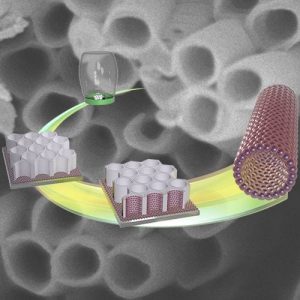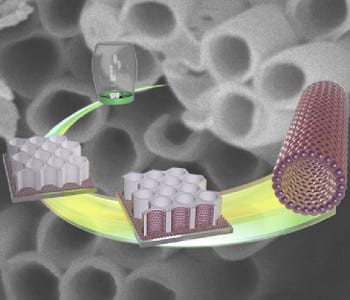In the development of nanotechnology, the fabrication of nanomaterials still relies highly on the usage of expensive instruments and time-consuming processing. Therefore, it is imperative to develop new methods for the fabrication of nanomaterials. Recently, a research group at National Chiao Tung University in Taiwan has made a breakthrough in preparing polymer nanomaterials. Led by Professor Jiun-Tai Chen, Ph.D. students (I-Chun Yao and Ming-Hsiang Cheng) developed a novel SAINT (solvent-annealing-induced nanowetting in templates) method, in which block copolymer micelles can directly infiltrate into nanopores and one-dimensional micelle nanotubes can be successfully fabricated.
 Block copolymer micelles are usually formed by using amphiphilic block copolymers in suitable solvent conditions. The main advantage of block copolymer micelles is their inherent ability to self-assemble. By changing environmental parameters, the morphologies of block copolymer micelles can be easily controlled and are suitable for large area processing. As a template, the research group used anodic aluminum oxide (AAO) which contains well-ordered nanopores. In this work, the researchers have intriguingly combined block copolymer micelles and AAO templates to fabricate one-dimensional block copolymer micelle nanotubes. Using this strategy, other kinds of materials can also be introduced to the hybrid templates, such as metals, metal oxides, or drugs. In the processing techniques, the one-dimensional nanostructures can even be extended to three-dimensions by fabricating free-standing, well-ordered arrays of micelle nanotubes, which can be applied to sensors, drug delivery, or advanced filtration techniques.
Block copolymer micelles are usually formed by using amphiphilic block copolymers in suitable solvent conditions. The main advantage of block copolymer micelles is their inherent ability to self-assemble. By changing environmental parameters, the morphologies of block copolymer micelles can be easily controlled and are suitable for large area processing. As a template, the research group used anodic aluminum oxide (AAO) which contains well-ordered nanopores. In this work, the researchers have intriguingly combined block copolymer micelles and AAO templates to fabricate one-dimensional block copolymer micelle nanotubes. Using this strategy, other kinds of materials can also be introduced to the hybrid templates, such as metals, metal oxides, or drugs. In the processing techniques, the one-dimensional nanostructures can even be extended to three-dimensions by fabricating free-standing, well-ordered arrays of micelle nanotubes, which can be applied to sensors, drug delivery, or advanced filtration techniques.
The researchers at National Chaio Tung University have proposed a preliminary model to explain the formation mechanism of the micelle nanotubes. Many questions, however, still need to be answered. For example, the mechanism of how metal nanoparticles can be introduced into the micelle nanotubes still requires further investigation. I-Chun Yao, first author of this work, says that the ability to control the micelles may also lead to self-assembled structures at the microscale, which may possess interesting surface properties. Therefore, the group will explore more possibilities on the self-assembly of the block copolymer micelles in different length scales.

















